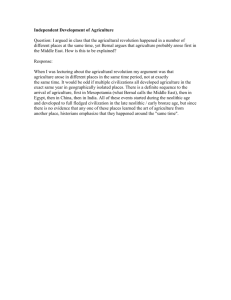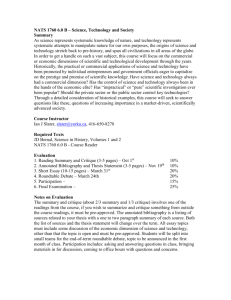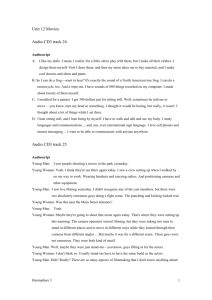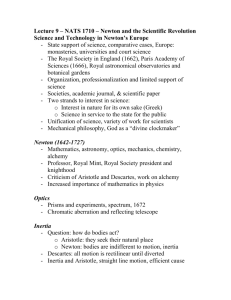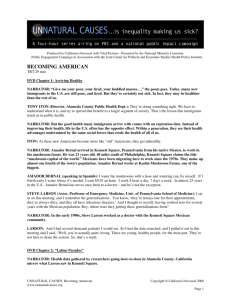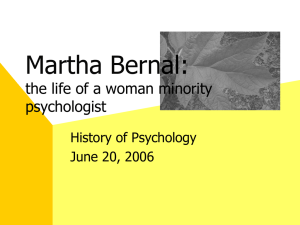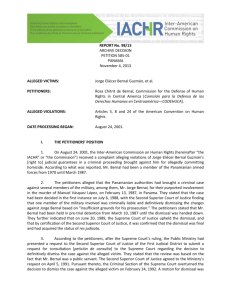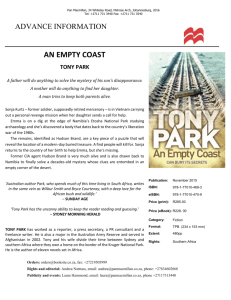Becoming American - Unnatural Causes
advertisement
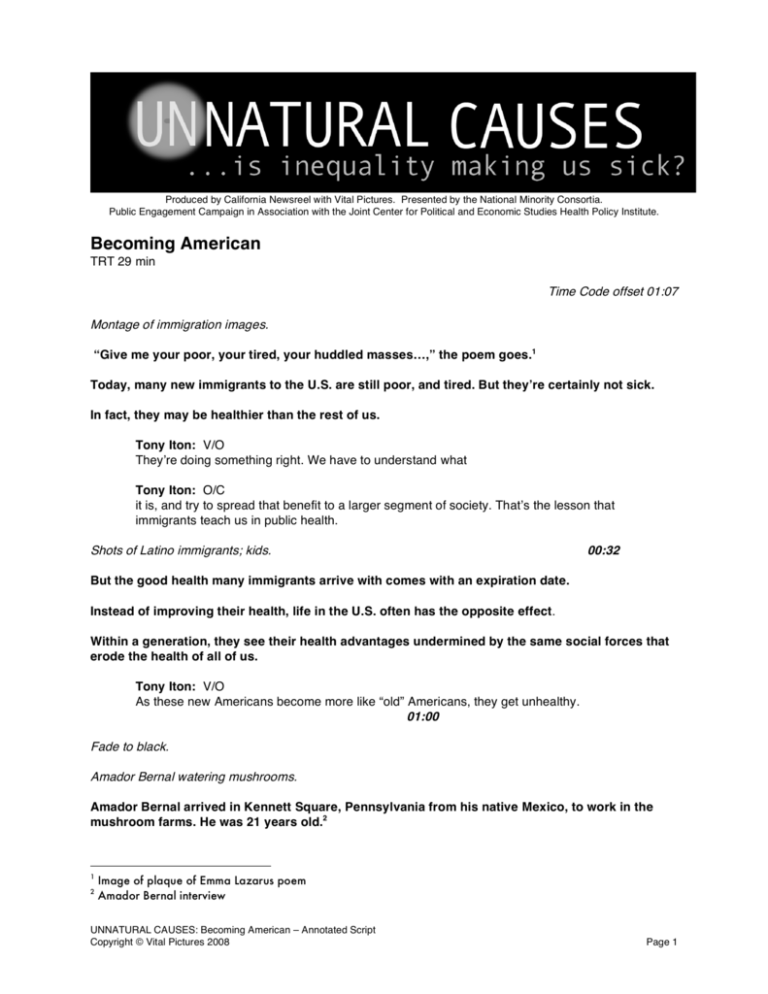
Produced by California Newsreel with Vital Pictures. Presented by the National Minority Consortia. Public Engagement Campaign in Association with the Joint Center for Political and Economic Studies Health Policy Institute. Becoming American TRT 29 min Time Code offset 01:07 Montage of immigration images. “Give me your poor, your tired, your huddled masses…,” the poem goes.1 Today, many new immigrants to the U.S. are still poor, and tired. But they’re certainly not sick. In fact, they may be healthier than the rest of us. Tony Iton: V/O They’re doing something right. We have to understand what Tony Iton: O/C it is, and try to spread that benefit to a larger segment of society. That’s the lesson that immigrants teach us in public health. Shots of Latino immigrants; kids. 00:32 But the good health many immigrants arrive with comes with an expiration date. Instead of improving their health, life in the U.S. often has the opposite effect. Within a generation, they see their health advantages undermined by the same social forces that erode the health of all of us. Tony Iton: V/O As these new Americans become more like “old” Americans, they get unhealthy. 01:00 Fade to black. Amador Bernal watering mushrooms. Amador Bernal arrived in Kennett Square, Pennsylvania from his native Mexico, to work in the mushroom farms. He was 21 years old.2 1 2 Image of plaque of Emma Lazarus poem Amador Bernal interview UNNATURAL CAUSES: Becoming American – Annotated Script Copyright © Vital Pictures 2008 Page 1 People working at Kaolin Mushroom Farms. 40 miles south of Philadelphia, Kennett Square claims the title “mushroom capital of the world.”3 Mexicans have been migrating here to work since the 1970s.4 They make up almost one fourth of the town’s population.5 Amador Bernal watering mushrooms. Amador Bernal works at Kaolin Mushroom Farms, one of the biggest.6 Amador Bernal: V/O I water the mushrooms with a hose and watering can, by myself. If I finish early I water where it’s needed. LOWER THIRD: 02:18 AMADOR BERNAL Amador Bernal: O/C I earn $9.03 an hour. I work 8 hous a day, 7 days a week. Amador at work, coiling a hose. In almost 25 years in the U.S., Amador Bernal has never once been to a doctor7 – and he’s not the exception. Steve Larson examining patients. Steve Larson: V/O I sat in on this meeting, and I remember the generalizations. (You know) they’re always late for their appointments, they’re always dirty… LOWER THIRD: STEVE LARSON, MD Assoc. Professor of Emergency Medicine Univ. of Pennsylvania School of Medicine 02:50 Steve Larson: O/C and they all have infectious diseases. And I thought to myself, having worked now for several years with the Mexican population: Boy, where were they getting these generalizations from? Larson examines patients; B-roll of fair. In the early 1990s, Steve Larson worked as a doctor with the Kennett Square Mexican community.9 Steve Larson: V/O 3 historickennettsquare.com; Google maps “The Evolution of the Mushroom Industry in Kennett Square,” by Samuel Flammini, 7/17/99; email from Victor Garcia, 9/24/07; “Mexican Enclaves in the US Northeast,” by Victor Garcia, 8/1997 5 U.S. Census Bureau 6 “Composting for Mushroom Moves Indoors,” New York Times, 9/13/98 7 Amador Bernal interview 9 Steve Larson interview 4 UNNATURAL CAUSES: Becoming American – Annotated Script Copyright © Vital Pictures 2008 Page 2 And I had several thousand patients I would see. So I had the data crunched, and I pulled it out in this meeting and I said, “Well, you’re actually quite wrong. These are young, healthy people, for the most part. They’re not here to drain the system. Steve Larson: O/C So, that’s a myth… Alameda County Public Health workers knock on doors. 03:23 Health data gathered by researchers going door-to-door in Alameda County, California mirror what Larson saw in Kennett Square. Tony Iton: V/O One of the things that the data told us, in our health department, LOWER THIRD: TONY ITON, MD Director Alameda County Public Health Dept. Tony Iton: O/C was that immigrant Latinos had the best health of anybody in the county, by far. They had the lowest rates of death, lowest rates of heart disease, lowest rates of all the major killers. And that was a startling finding to us. We couldn’t understand why the poorest, most socially marginalized population actually had the best health.10 03:45 Tony Iton: V/O Better health, not just than other poor people, but better health Tony Iton: O/C than the wealthiest segments of our societies.10A And that’s profound. Alegría and other scientists at table talking. On the other side of the country in Cambridge, Massachusetts, Dr. Margarita Alegría leads a team looking at a similar phenomenon through the lens of mental health.11 Close-ups of charts and graphs being studied. In the 1960s, researchers identified what they called the “Latino paradox.”12 Margarita Alegría: V/O They were surprised to find that Latinos LOWER THIRD: MARGARITA ALEGRÍA 04:39 10 Tony Iton email, 7/24/07 Email from Tony Iton, 9/24/07 11 Margarita Alegria interview 12 “The Health of Hispanics in Southwestern United States: an Epidemiologic Paradox,” Markides and Coreil, Public Health Reports May-June1986; "Acculturation and Lifetime Prevelance of Psychiatric Disorders Among Mexican Americans in Los Angeles," Burnam, Houghl, Karno et al, Journal of Health and Social Behavior, Mar 1987; “Introduction: Migration and Health,” Evans, Jeffrey, Int’l Migration Review, 1987; email from Dolores Acevedo-Garcia 10A UNNATURAL CAUSES: Becoming American – Annotated Script Copyright © Vital Pictures 2008 Page 3 Psychologist, Harvard Medical School Cambridge Health Alliance Margarita Alegría: O/C that were immigrant, who had lower education, lower income, were under very stressful conditions of adaptation to the US, had actually lower rates of psychiatric illness than whites who were higher income, higher education.12A Margarita Alegría: V/O 04:53 And this has also been shown in cardiovascular disease and cancer and other illnesses. Margarita Alegría: O/C So it’s quite a paradox. B-roll of physical exams of Latinos. One explanation is that Latino immigrants who come here have better health on average than those who stay behind.13 But researchers are also circling in on a second hypothesis. Bernals unload groceries in kitchen; Margarita Alegría interview. Margarita Alegría: V/O I think the other explanation has been more about the role of very strong, cohesive family ties that hold Latino families together, even under hardship; and these very strong family ties facilitate people struggling through Margarita Alegría: O/C (you know) disadvantageous conditions. Amador Bernal drives; Amador Bernal interview. 05:43 For 20 years Amador Bernal traveled back and forth between Mexico and Kennett Square.14 Amador Bernal: V/O (subtitles): I’d work 4,5,6 months and I’d go home because I missed them so much… Amador Bernal: O/C (subtitles): all of them, but especially Maritza…. I used to dream about her. After he got his green card, Amador filed papers for his family to join him.15 It took nine years to get approval.16 They finally arrived in the U.S. a year ago.17 12A Ibid “The Latino mortality paradox: a test of the “salmon bias” and healthy migrant hypotheses,” Abraido-Lanza, Dohrenwend, et al., Am J of Public Health, Oct 1999; “Hispanic Paradox: Income may be lower but health better than most,” Juliet Chung, Los Angeles Times, 8.29.06; “Do Hispanics have health edge?,” Jacob Goldstein, Miami Herald, 9.28.06 14 Amador Bernal interview 15 Ibid 16 Ibid 17 Ibid – Arrived in May 2005 13 UNNATURAL CAUSES: Becoming American – Annotated Script Copyright © Vital Pictures 2008 Page 4 The Bernal family eats pizza. 06:09 Amador Bernal: V/O It’s much better for me because I’m not apart from them…I see them everyday. Amador and his wife Bernardita have lots of family in Kennett Square. They help ease the stress of settling in a new country. Bernardita Bernal: V/O (subtitles) His father helped us buy the table. LOWER THIRD: BERNARDITA BERNAL 06:55 Bernardita Bernal: O/C (subtitles) My father gave us money to buy the TV and microwave. Family gathers in the Bernal home, talks and eats together. Amador Bernal: V/O (subtitles) Her brothers don’t have a car. Amador Bernal: O/C (subtitles) So they say, “Take me to Walmart,” and I take them. Amador Bernal: V/O (subtitles) Like that. We help each other. That’s how we solve our problems. B-Roll of gathering. 07:31 Tony Iton: V/O Immigrants bring to this country aspects of culture, of tradition, of tight family social networks and community social networks that essentially form a shield around them Tony Iton interview Tony Iton: O/C and allow them to withstand the deleterious, the negative impacts of American culture. Exterior shot of Bernal home. 07:41 But maintaining the support networks of close family and community is becoming increasingly difficult--for all Americans. Cars/traffic; wide shot of office cubicles. We now work longer hours than any other industrialized nation, even Japan.18 The average American now spends fifty minutes a day commuting. Ten million of us take two hours or more.19 18 State of Working America, 2006/7 reporting 2004 OECD data, International Labour Organization news release, September 6, 1999 19 U.S. Census Bureau, 2005 American Community Survey UNNATURAL CAUSES: Becoming American – Annotated Script Copyright © Vital Pictures 2008 Page 5 One in four Americans say there is no one with whom they discuss important matters. That number nearly tripled in the last twenty years.20 Social isolation is on the rise in the United States. B-roll of street – cars and people go by; ext. mural shot. And Isolation can kill. That was the finding of a seminal study conducted in California in the 1970s.21 Lisa Berkman: V/O It was astounding. Overall, people who are really isolated are at increased risk not only for cardiovascular disease, but for LOWER THIRD: 08:48 LISA BERKMAN Epidemiologist Harvard School of Public Health Lisa Berkman: O/C infectious diseases, for diabetes, for strokes, for cancer. They were at increased risk from almost every cause of death.22 Street B-roll; CU of heart rate monitor; Lisa Berkman interview. 09:08 Lisa Berkman: V/O Social isolation kind of metaphorically accelerates the rate of aging. The fact that you got something when you were 50 instead of 80, or 30 instead of 60, is because Lisa Berkman: O/C being socially isolated is a chronically stressful situation, which just kind of leans on the body. The Bernals unload groceries from car. But staying socially connected in a way that protects health takes more than close family ties. Tony Iton: V/O That’s one of the lessons of America that your family isn’t enough ultimately to Tony Iton: O/C protect you against some of the influences of America. The Bernals enter their home; closeup of shoes on porch railing. Tony Iton: V/O It really is a challenge to try to make sure that before the 20 “Social Isolation in America: Changes in Core Discussion Networks over Two Decades,” McPherson, SmithLovin, and Brashears, American Sociological Review, June 2006 21 “Social Networks, Host Resistance, and Mortality,” Berkman and Syme, American Journal of Epidemiology, 1979; Lisa Berkman email 22 “The Role of Social Relations in Health Promotion,” Berkman, Psychosomatic Medicine, 57:245-254, KT sent email to Berkman, 7/26/07 UNNATURAL CAUSES: Becoming American – Annotated Script Copyright © Vital Pictures 2008 Page 6 Tony Iton: O/C inevitable breakdown of these close family units occurs 09:47 Tony Iton: V/O that the communities are organized in ways to essentially keep that (sort of) protective shield alive. The Bernal boys leave high school; street scenes of Kennett Square; people buy produce from farm stand. The Bernals may have found some of that community support in Kennett Square itself. It’s a Pennsylvania town with a Quaker sense of mission, and it does more than many communities to invest in its future with good schools, social services, and many other resources to support all its families. Victor Garcia: V/O I think what makes Kennett Square so unique in that regard LOWER THIRD: VICTOR GARCIA Cultural Anthropologist Indiana Univ. of Pennsylvania 10:28 Victor Garcia: O/C are the different organizations that are trying to not just bridge Victor Garcia: V/O and create a link with the immigrant population, but is also I think helping this population not fall into the category of being underclass. People gather in community center for meeting. Everyone benefits if no one is left behind. That was the idea behind “Bridging the Community” meetings begun by Joan Holliday in 1997.23 LOWER THIRD: JOAN HOLLIDAY Public Health Nurse Bridging the Community 10:58 Joan Holliday: O/C I, as a public health nurse, felt this community had so many resources for being such a small town Joan Holliday: V/O but we weren’t talking to each other. More people arrive in community center for meeting. The meetings are an opportunity for residents to find out about resources available in the area and exchange services.23A 23 Email from Joan Holliday, 1/17/2007 Ibid 23A UNNATURAL CAUSES: Becoming American – Annotated Script Copyright © Vital Pictures 2008 Page 7 Linda Eckman: O/C Linda Eckman and I’ve been in this community 23 Linda Eckman: V/O years and I’m starting a twelve-step group for kids Linda Eckman: O/C with addiction issues. 11:24 Fidel Vasquez: Mi nombre es Fidel Vazquez. Translator: My name is Fidel Vasquez. Fidel Vasquez: Trabajor de Kaolin, de pick de hongo. Translator: I work at Kaolin Mushroom and I pick mushrooms. Woman: If you know of anyone who wants part-time or full-time or anything – we just really have a great need for a bilingual receptionist. People talk at the meeting. Victor Garcia: V/O There are people in poverty here. There are people here with need. But I don’t think it’s a Victor Garcia: O/C large population that find themselves in dire straits. Not like you would find Victor Garcia: V/O in similar communities in other areas of the United States. B-roll of Garage youth center. 12:05 Another resource for families is The Garage, the town’s youth center. After school, students come here to work with volunteers, use the computer lab, or just hang out.23B Alfredo Bernal at table with other students. Alfredo Bernal often comes here to do his homework. His brother Israel practices his English with a retired executive. MCU on boys doing homework. LOWER THIRD: ISRAEL BERNAL 12:35 Israel Bernal: V/O (subtitles) 23B Patty Olenik email 1/18/2007 UNNATURAL CAUSES: Becoming American – Annotated Script Copyright © Vital Pictures 2008 Page 8 New doors have opened for me here. Israel Bernal: O/C (subtitles) I’d like to study engineering… MCU of Garage flyer; pan to woman. Israel Bernal: V/O (subtitles) go to Penn State for example. Here, if they see you’re intelligent and really work hard, they support you. CU of Alfredo Bernal working. Alfredo Bernal: V/O (subtitles) My hopes are to study social work, LOWER THIRD: 12:59 ALFREDO BERNAL Alfredo Bernal: O/C (subtitles) so that I can help people who come from Mexico or really, anyone who needs help. Kids doing homework and playing foosball at The Garage. 13:07 Community support in Kennett Square gives Alfredo and Israel reason to be hopeful as they look ahead. And if they can climb the eonomic ladder they stand a better chance of a healthy future. Tony Iton: V/O In America Tony Iton: O/C wealth pretty much equals health. And that’s true for me as it is true for (you know) the poorest person in, in the (quote, unquote) inner city. Tony Iton interview; Gradient animation Tony Iton: V/O There’s a gradient. And all the way along the way, you can find yourself somewhere along that gradient. Tony Iton: O/C 13:43 It’s not like you’re poor and you have bad health, and then you’re not poor and you have good health. Tony Iton: V/O For each step along that wealth gradient, you have a corresponding step of health. Bernardita Bernal serves dinner; Tony Iton interview; ext of Bernal home. Tony Iton: V/O When you’re a new immigrant, the relationship between wealth and health is relatively loose. As you become more American, that relationship Tony Iton: O/C UNNATURAL CAUSES: Becoming American – Annotated Script Copyright © Vital Pictures 2008 Page 9 becomes tighter and tighter and tighter. Ext shots of Bernal home; After only 5 years in the U.S., Latino immigrants are one and a half times more likely to have high blood pressure than when they first arrived – and to be obese. Animation: High Blood Pressure New Immigrants: 13%, After 5 Years: 20% Obesity New Immigrants: 16%, After 5 Years: 22% Rates of heart disease and diabetes also increase.24 Ext shot of trailer homes; tracking shot of poor housing. More than 20% of Latino households are poor.24A The longer they’re here, the more immigrant families struggle with discrimination, low-paying jobs, bad schools, and bad housing. Tony Iton: V/O 14:50 And if that environment is giving you cues that you’re not valuable, that you have very little prospect for a good future, that starts to build up and you internalize that devaluation. Teenagers walking on street and hanging out in front of stores. One in four Latino children drop out of high school.25 Shockingly, one in seven teenaged Latina girls attempt suicide.26 Tony Iton: V/O 15:18 Immigrant Latinos, as they acculturate, as the stress levels accumulate, their children start to lose that sense of why it is that they were here, Tony Iton: O/C they lose that connection to their parent’s hopefulness. They become more American, they acquire American habits, American diets, Tony Iton: V/O American sensibilities. They’re gaining traction in the American way of life, Tony Iton: O/C but they’re losing that hopefulness that their immigrant parents Tony Iton: V/O brought with them that might actually be health-protective. The Bernal family eats dinner at table. 24 CDC, Advance Data from Vital and Health Statistics, March 1, 2006 Pew Hispanic Center; email verification from Pew Hispanic Center Information, 1/22/07 25 National Center for Educational Statistics 26 “Youth Risk Behavior Surveillance—United States,” 2005, MMWR, CDC 24A UNNATURAL CAUSES: Becoming American – Annotated Script Copyright © Vital Pictures 2008 Page 10 Today the Bernals are still healthy. But they’re facing the same kinds of pressures and stresses many of us live with day in and day out. Wide shot/pan across mushroom factory. 15:58 Bernardita Bernal packs mushrooms. CU of mushroom containers coming down the line; women pack containers. Bernardita Bernal: V/O We put on the lids, Bernardita Bernal: O/C the labels… We weigh the boxes… Bernardita Bernal: V/O They come out fast, 12 or 15 boxes a minute. I work 9 or 10 hours a day. of mushrooms we work six days a week. Bernardita earns $6.50 an hour.27 If there are a lot 16:33 Amador, Bernardita and Alfredo in the van. Like many American families, the Bernals need as many incomes as they can generate. Alfredo Bernal: V/O (subtitles) My brother and I work in a restaurant, Longwood Garden, as dishwashers. Before working here, I worked afternoons from 4 o’clock Alfredo Bernal: O/C (subtitles) and sometimes I didn’t leave until late… and I’d be so tired when I got home I’d just fall asleep, so I wouldn’t do my homework and then my grades went down. Alfredo Bernal: V/O (subtitles) That’s why I prefer to only work weekends. Alfredo Bernal: O/C (subtitles) Did anyone call? Bernadito Bernal: O/C (subtitles) Yes, someone called. 17:34 Alfredo Bernal: O/C (subtitles) Who was it? Bernardita Bernal: O/C (subtitles) Some girl. Alfredo Bernal: O/C (subtitles) I wonder which of the two. No, no, just kidding. 27 Amador Bernal interview; email verification from Maria Teresa Rodriguez 2/12/07 UNNATURAL CAUSES: Becoming American – Annotated Script Copyright © Vital Pictures 2008 Page 11 Driving shots of huge homes. Pan across ext. of Bernal home Like half of American households,28 the Bernals live on about $46,000 a year.29 And they’re trying to make ends meet in one of the most upscale counties in Pennsylvania.30 Even renting a small house by the train tracks is expensive. Amador Bernal at kitchen table paying bills 18:13 Three fourths of their income goes to basic expenses, like rent, food, utilities and transportation—for a family of six.31 Bernal family enter grocery store Amador Bernal: (subtitles) Turkey. Turkey’s on special. Bernal family looks at products in aisles. Three out of four of Americans who started out at the bottom of the income ladder in the late 1980s were still there a decade later.32 Tony Iton: V/O There’s this mythology of the American dream that (you know) anybody can move up that ladder with the right amount of gumption. And there’re certainly anecdotal stories of that, and people have good luck, and good fortune. But for the most part Tony Iton: O/C the overwhelming majority of people don’t move up that ladder. The Bernals check out at supermarket cashier. 19:06 These economic insecurities erode the social and family ties that support our health. LOWER THIRD: OLGA BERNAL 19:18 Olga Bernal: (subititles) We can’t have our parents all the time… like in Mexico, my mom would be there when I got home from school. Here, when I get home I’m alone until my sister comes home, and my Dad. Then he goes to pick up my Mom. Workers stack and load boxes of mushrooms. 19:34 Tony Iton: V/O One of the things that we know that immigrant parents do is that they work, and they work a lot. And so as a consequence, their children have less time with them, they have less exposure to them, to those cultural 28 U.S. Census Bureau Amador Bernal interview 30 US Census Bureau 31 Amador Bernal interview 32 “The State of Working America 2004-05,” Economic Policy Institute 29 UNNATURAL CAUSES: Becoming American – Annotated Script Copyright © Vital Pictures 2008 Page 12 Tony Iton: O/C aspects of family, of community that – that parents inculcate in their children. The Bernal girls play with makeup. Olga and Martiza were 11 and 8 when they came to the U.S.33 When social and family ties begin to fray, it’s the mental health of the youngest arrivals that’s the most vulnerable. The risk of psychiatric disorders for Latino immigrant children depends on their age when they arrive here.34 B-roll of young Latinos entering building, dancing, and hanging out outside; Margarita Alegría interview. Margarita Alegría: V/O The longer you stay in your country of origin, for especially the times where you have a higher risk LOWER THIRD: MARGARITA ALEGRÍA Psychologist, Harvard Medical School Cambridge Health Alliance Margarita Alegría: O/C 20:35 of developing illnesses like psychiatric disorders, like anxiety, or like depression – the longer you stay in your country of origin, Margarita Alegría: V/O the lower the risk you’re going to have of developing those disorders. Margarita Alegría: O/C What is it in this country that suddenly increases your risk for psychiatric illness? What are we doing here? William Vega and others sit at a table and discuss. 20:59 William Vega has studied the psychological health of Mexican immigrants in California. Father feeds daughter at community dance; William Vega interview. William Vega: V/O If nothing else, the paradox is putting the spotlight LOWER THIRD: WILLIAM VEGA Psychiatric Epidemiologist David Geffen School of Medicine – UCLA 33 Amador Bernal Interview “Prevalence of Psychiatric Disorders Across Latino Subgroups in the United States,” Alegria, Melvaney-Day, et al., Disentangling Mental Health Disorders, Jan 2007, Vol. 97, No. 1; Vega, William, The Journal of Nervous and Mental Disease, 2004 34 UNNATURAL CAUSES: Becoming American – Annotated Script Copyright © Vital Pictures 2008 Page 13 William Vega: O/C on the fact that the United States has very high levels of depression. People dance; William Vega interview William Vega: V/O And we found when we looked at the population that came as immigrants and had about 13 years or less in the country, they had very, very low levels of major depression. Only about 8%. The general population in the United States William Vega: O/C that would be about 18-20% in a lifetime. William Vega: V/O But those levels increased when we looked at people who had been in the country over 13 years.35 William Vega: O/C 21:36 See these protective factors begin to wear down. And then subsequently over multiple generations William Vega: V/O we can anticipate that they’ll look increasingly just like William Vega: O/C the American people as a population, because they live here. They’ve become Americans. Fade to black. Workers harvest mushrooms in the grow houses. 21:50 For immigrant mushroom workers, becoming an American is a journey filled with opportunity, challenges and risks. A number of workers are beginning to feel the affects of newly diagnosed chronic diseases. Peggy Harris with patient. Peggy Harris: O/C (subtitles) Does anyone in your family have diabetes? Patient: O/C (subtitles) I have it. Peggy Harris: O/C (subtitles) You have it? When was it diagnosed? Patient: O/C (subtitles) Oh, about nine months ago. 35 22:20 see email in binder from William Vega, 8/3/07 UNNATURAL CAUSES: Becoming American – Annotated Script Copyright © Vital Pictures 2008 Page 14 Harris continues examining patient. Like almost half of America’s workforce, mushroom workers get no paid sick days.37 Recently, three mushroom farms allowed La Comunidad Hispana, a social service agency in Kennett Square, to open clinics on-site.38 Peggy Harris: V/O Workers don’t like to take time off from work. LOWER THIRD: MARGUERITE HARRIS Clinical Health Director Project Salud 22:44 Peggy Harris: O/C It’s money not being earned and they really do need to earn money. So that they would not necessarily go to see anybody until symptoms are pretty bad. Peggy Harris: V/O Obesity probably is the leading issue here Peggy Harris: O/C and along with that comes all the other problems of diabetes and hypertension, hypercholesterolemia, Peggy Harris: V/O And of course with all of that you have strokes coming down the pike, congestive heart failure. So we do a screening of all Peggy Harris: O/C of those for whatever reason a patient comes in. That’s the protocol. Examination room in clinic; Harris examines patients. By the year 2050, one in four Americans will be Latino.39 Steve Larson interview; patient in clinic. Steve Larson: V/O If we acknowledge that this is the population that’s growing, then you know, we have to Steve Larson: O/C plan for 20 years from now, 30 years from now. 23:33 Steve Larson: V/O If wellbeing isn’t prioritized now, then what’s the landscape of our country going to look like Steve Larson: O/C 37 U.S. Dept. of Labor, Bureau of Labor Statistics; email verification from KW Union Verification from Courtney at La Comunidad Hispana 39 Pew Charitable Trusts; La Raza; NIH; US Census Bureau 38 UNNATURAL CAUSES: Becoming American – Annotated Script Copyright © Vital Pictures 2008 Page 15 twenty, thirty years from now? Amador Bernal working at mushroom factory; Amador Bernal interview. Amador Bernal: V/O (subtitles) If I had credit, I would like to buy a house. But right now we have nothing saved. 23:57 Amador Bernal: O/C (subtitles) When you have a little money Amador Bernal: V/O (subtitles) then you can get more credit for a house, and pay for it little by little. The Bernal children do their homework. The Bernals are hopeful about their future. But can they maintain their hope—and their health— as they become more American, and as America becomes more a part of them? The Bernal kids at home; William Vega interview. William Vega: V/O When we talk about acculturation and the process of becoming more Americanized, it’s not a process of changing cultures A to Z. LOWER THIRD: WILLIAM VEGA Psychiatric Epidemiologist David Geffen School of Medicine-UCLA 24:40 William Vega: O/C It’s a process of selectively taking on elements of American culture. And I think if we can bring that selection process into clearer focus, of which processes are selected and which are not selected, and which are retained from the old culture, you have a better mix. Parade and fair shots; Tony Iton interview. And this may have lessons for all of us. Tony Iton: V/O 24:58 As a society, we can build hope. And we do that by giving people access to Tony Iton: O/C those things that give them the potential for success: that’s good education, that’s access to good jobs, Tony Iton: V/O 25:12 decent housing, and then a sense of belonging to a community, belonging to something larger than yourself, larger than your family. The potential right now is to try to take what we can see Tony Iton: O/C obviously in new immigrant communities—the health protective benefits of being a new immigrant—and understand and translate that into public health interventions now Tony Iton: V/O UNNATURAL CAUSES: Becoming American – Annotated Script Copyright © Vital Pictures 2008 Page 16 that affect the broader community. Fade to Black THE END UNNATURAL CAUSES: Becoming American – Annotated Script Copyright © Vital Pictures 2008 25:48 Page 17
